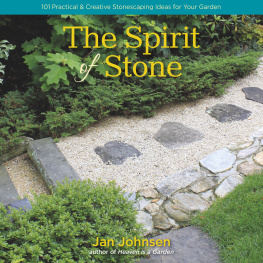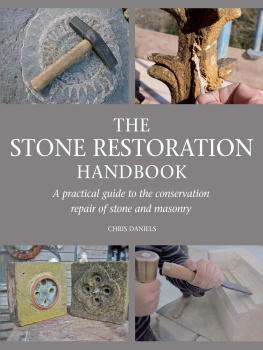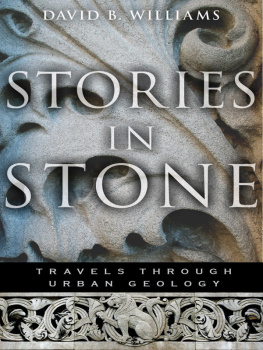Practical Stone Masonry
This book is dedicated to
the memory of the late
BILL HOLLAND
sometime Foreman Mason, York Minster
A man of fearlessly individual opinion,
to whom so much is owed
Practical Stone Masonry
P. R. HILL
Stone Consultant
AND
J. C. E. DAVID
Setter-out, York Minster

First published in the United Kingdom 1995 by
Donhead Publishing Ltd
This edition published 2013 by Routledge
2 Park Square, Milton Park, Abingdon, Oxon OX14 4RN
711 Third Avenue, New York, NY 10017
Routledge is an imprint of the Taylor & Francis Group, an informa business
P. R. Hill and J. C. E. David 1995
All rights reserved.
No part of this book may be reproduced or transmitted in any form or by any means electronic, mechanical or otherwise without prior permission from the publisher.
ISBN13 978 1 873394 14 4 (hbk)
A CIP catalogue for this book is available from the British Library
Typeset by Carnegie Publishing, Preston
Contents
This book is intended for use by working masons and apprentices, and those engaged in planning and supervising such works. The emphasis is directed towards masonry techniques used in the repair and preservation of stone buildings, for it is in this area that the majority of traditional masonry skills are practised today. Few new buildings are now of solid, dressed stone, although many of the techniques and other information presented here apply equally to new and repair work of a traditional nature. Neither stone cladding nor the hanging of solid stonework on steel frames are covered.
Anyone writing on the technical aspects of masonry must have in mind the book which for many years has been the stone masons bible: Modern Practical Masonry by E. G. Warland, first published in 1929. Warland presented a picture of a highly mechanized trade, where machinery was essential to keep down costs and help stone to compete more effectively with other materials, the mason being used only for those details which could not be done by machine. He was writing at a time when the traditional stone trade was strong and in a position to compete with new materials such as concrete. Even steel-framed buildings were being clad in solid stone rather than with a veneer of thin slabs. Warlands book was a successor to Practical Masonry by W. R. Purchase, published in 1895, in which machinery is not mentioned but banker work is given only nine pages, as apprentices would have been expected to receive most of their training directly from a skilled mason. Most of the contents of both books are concerned with the geometry and setting-out of masonry details, and are directed entirely towards new work, which is infinitely simpler than repair work.
The chapter headings in this book are not dissimilar to those in Warland, but the content has a very different direction. Since the 1950s, both the commercial and educational emphasis has been on new techniques and methods of using stone and, although there has been a revival in the stone trade since the 1960s and 1970s, and many stone buildings are being repaired instead of demolished, there is a large gap in the understanding of traditional masonry by those supervising such contracts. There is little educational material directed towards high-class repair work for the benefit of the apprentice mason. Much of the literature on the care of stone buildings has been directed towards preserving as found rather than repairing, or has been written by those often having only the smallest understanding of the craft of the stone mason. This book aims to fill that gap by presenting, in an accessible form, the essentials of setting-out, working and fixing for repairs, as it is these skills which form the core of the masons trade. While it is essential for the mason to have some understanding of other aspects of the repair of historic buildings, such as cleaning and surface treatments, techniques and philosophies are constantly changing, and only broad outlines are given here. In every case suggestions for further reading are included.
It is not only masons, and particularly apprentice masons, who can learn from this book. All those concerned in the specifying and supervising of stonework, and those whose primary interest is the conservation, in its widest sense, of ancient buildings, can learn much from these pages. A knowledge of basic geology, causes of decay and methods of cleaning, can be learned, and in much greater detail, from other works. However, a full and practical description of what is, or more importantly should be, involved in full-size setting-out from existing detail and subsequent working and repair cannot be found elsewhere at the time of writing. A careful reading and understanding of , where the problems of supervision and some idea of the conflicting schools of thought among those in overall charge of the maintenance of building are considered. From the banker, or the architects office, the world can appear to be a very simple place. It is far from it, and the gap in understanding between the theoretician and the practitioner must be bridged.
Any mason today must have an awareness of the possibilities for conservation of stone as an alternative to replacement. Conservators have multiplied since the 1970s and, as a result, many buildings are maintained using conservation rather than masonry techniques. While it is unfortunately true that many conservators come from an academic rather than a trade background and have seen their skills as being superior, the conservator should be seen as an ally rather than an enemy. This book is not the place to discuss the wide range of conservation techniques available but the mason should be aware of them and the bibliography lists some introductory material.
Although today the interest in masonry skills is greater than for many years, some entrants see it as a rather romantic trade. Nothing could be further from the truth; it could be summed up as heavy, dusty and dirty, and, at times, tedious to say the least. There is little romance about fixing high on a scaffold in the teeth of a bitter east wind. Many of the romantics depart at this point, the time spent on training them being a loss to the trade. On the other hand, many large masonry firms are now producing worked stone from rough block to finished product entirely by the use of computer-controlled machinery. There is nothing wrong with that, and for new building work it is an economical and sensible way to run a business. It can be less satisfactory for repair work, where the startling accuracy stands out amid the mediaeval human frailty. Also, there is the temptation to simplify mouldings to ensure that they can be worked by machine, which is not the best way to conserve an old building.
The craft of the mason can only be learned and maintained by diligence and persistence over many years. It takes eight or ten years to make a useful all-round mason. It is then that the heavy, dirty work begins really to pay off in terms of job satisfaction. Both the factors in the previous paragraph militate against the long-term training of the traditional mason who, despite all the new machinery, is still the most vital element in the maintenance of stone buildings.
The authors should not be seen as opposed to machinery in the stone trade; anything which reduces tedious roughing-out is most welcome. But there is a place for everything, and there is a danger that the banker mason will disappear from the scene. Add to these factors the attitude of those conservationists who would rather see a building crumble to dust rather than intervene and, when the need for truly skilled traditional masons arises, they may not be there. There are already too many so-called masons who are nothing of the sort but whose work is accepted because there is no one else, or because no one knows any better. The chapter covering supervision should help to rectify the last point.
Next page











